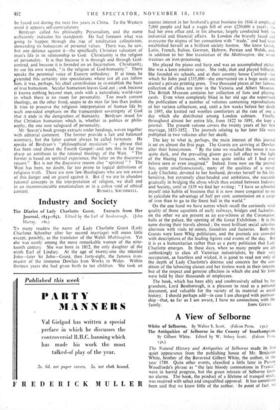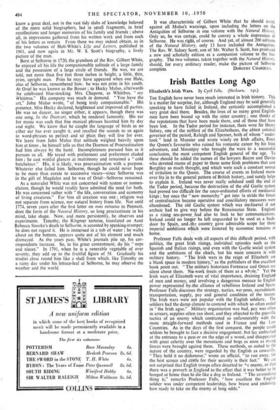A View of Selborne
White of Selborne. By Walter S. Scott. (Falcon Press.
The Natural History and Antiquities of Selborne made its first quiet appearance from the publishing house of Mr.. Benjamin White, brother of the-Reverend Gilbert White, the author, in the year 1789. Quite other events, classified a little later in Parson Woodforde's phrase as "the late bloody commotions in France, were in horrid progress, but the green retreats ofSelborne knee' no alarms. The book, the product of a lifetime of tranquil study. was received with select and unqualified approval. It has sometimes been said that we know little of the author. In point of fact. we
know a great deal, not in the vast tidy slabs of knowledge beloved of the more solid biographers, but in small fragments, in brief recollections and longer memories of his family and friends ; above all, in impressions gathered from his written work and from such of his letters as remain From these we may indeed obtain, as in the two volumes of Holt-White's Life and Letters, published in 1901, and now again in Mr. W. S. Scott's biography, a lively picture of the man.
Born at Selborne in 1720, the grandson of the Rev. Gilbert White, he enjoyed all his life the companionable solitude of a large family and the possession of a large circle of friends. He was, we are told, not more than five feet three inches in height, a little, thin, prim, upright man. Prim he may have appeared when one Hale, also of Selborne, remembered him: he was not prim in his youth. At Oriel he was known as the Busser ; to Hecky Mulso, afterwards the celebrated blue-stocking. Mrs. Chapone, as Whitibus, "my Whitibus." His company was much in demand. "You have the art," John Mulso wrote, "of being truly companionable." His presence, Miss Hecky declared, heightened and improved all parties. He was no dancer, no singer either, it appears, though there was one song, In the Dustcart, which he rendered famously. His ear for music was such that fine musical phrases haunted him by day and night. We know that he caught the language of birds as no other ear has ever caught it, and recalled the sounds to us again in word-phrases so perfect and so plain they will live for ever. We learn from John Mulso that solitude weighed heavily upon him at times , he himself tells us that the Daemon of Procrastination had him always by the hand. Incompleteness pursued him as it pursues us all. He toyed with preferment and preferment eluded him ; he cast wistful glances at matrimony and remained a "cold batchelour." His, it is likely, was procrastination with a purpose. Whatever else failed him. Selborne, though he could never hope to be more than curate to successive vicars—since Selborne was in the gift of Magdalen and he was of Oriel—Selborne remained.
As a naturalist White was not concerned with system or nomen- clature, though he would readily have admitted the need for both. He was concerned rather with "the life, conversation and economy of living creatures." For him all creation was one ; religion was not separate from science, nor natural history from life. Not until 1774, seven years after the first letter on mus minutus to Pennant, does the form of the Natural History, so long procrastinate in his mind, take shape. Now, and more persistently, he observes and experiments. Timothy, the Ringmer tortoise, translated on Aunt Rebecca Snooke's death to Selborne, is accosted by spvaking-trumpet; he does not regard it. He is immersed in a tub of water ; he walks about on the bottom, appears quite out of his element and much dismayed. As the years pass, White's journals pile up, his cor- respondents increase. So, to his great contentment, do his " neps and nieces." In 1791, when he is a venerable vegetable of over seventy, they add up to the fruitful figure of 58. Gradually his studies close round him like a shell from which, like Timothy on a rainy day under his lettuce-leaf at Selborne, he may observe the weather and the world.
It was characteristic of Gilbert White that he should insist, against all Mulso's warnings, upon including the letters on the Antiquities of Selborne in one volume with the Natural History. Only so, he was certain, could he convey a whole impression of Selborne. He was right, of course. And yet, of almost 200 editions of the Natural History, only 13 have included the Antiquities. The Rev. W. Sidney Scott, son of Mr. Walter S. Scott, has produced a new and scholarly edition as a companion volume to the bio- graphy. The two volumes, taken together with the Natural History, should, for every ordinary reader, make the picture of Selborne



















































 Previous page
Previous page